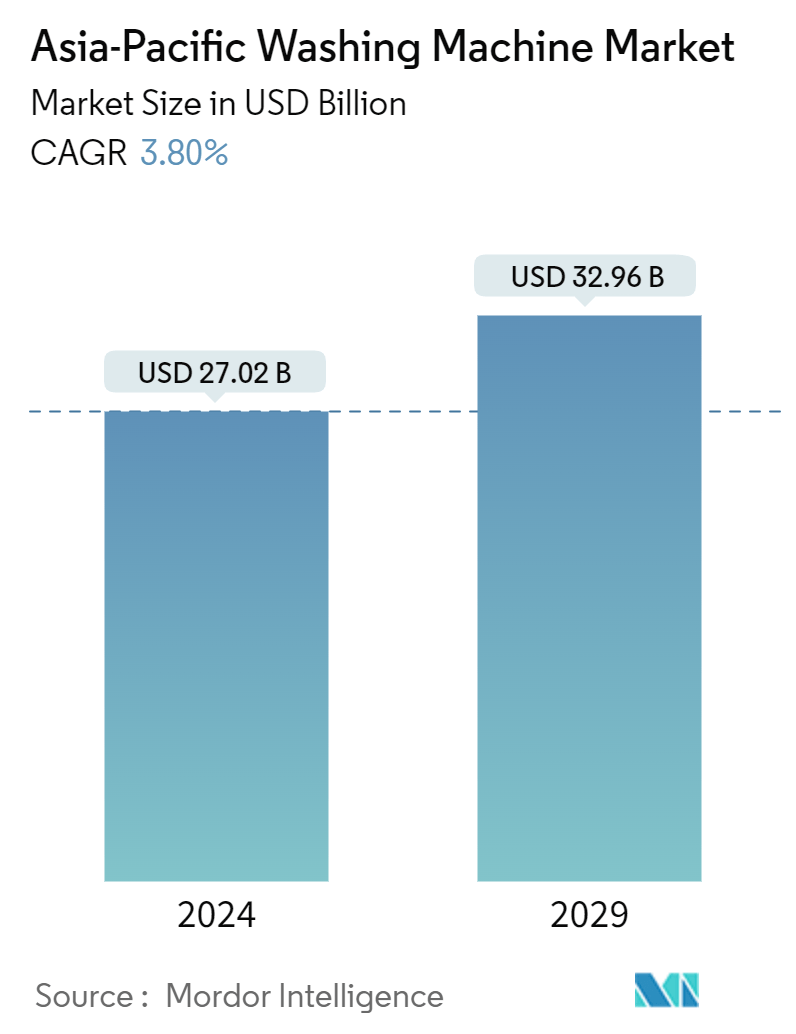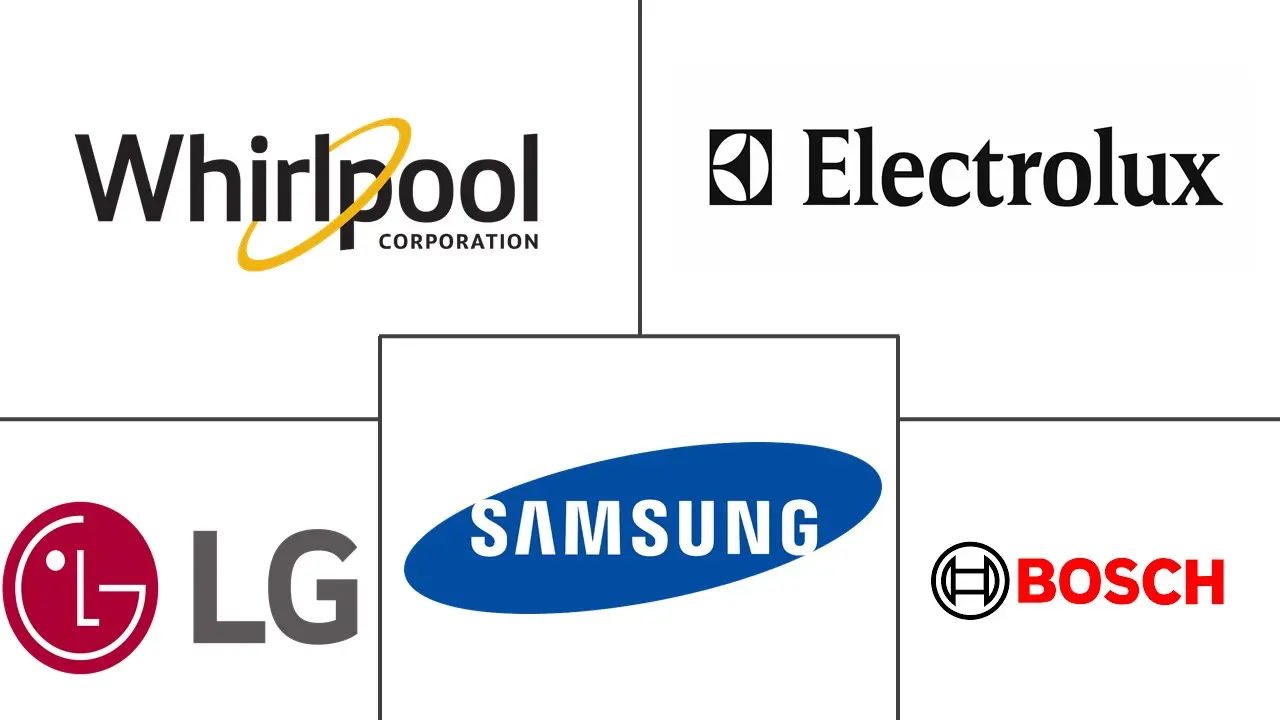Market Size of Asia-Pacific Washing Machine Industry

| Study Period | 2020 - 2029 |
| Base Year For Estimation | 2023 |
| Market Size (2024) | USD 27.02 Billion |
| Market Size (2029) | USD 32.96 Billion |
| CAGR (2024 - 2029) | 3.80 % |
| Market Concentration | Medium |
Major Players
*Disclaimer: Major Players sorted in no particular order |
Asia-Pacific Washing Machine Market Analysis
The Asia-Pacific Washing Machine Market size is estimated at USD 27.02 billion in 2024, and is expected to reach USD 32.96 billion by 2029, growing at a CAGR of 3.80% during the forecast period (2024-2029).
The Asia-Pacific washing machine market is experiencing growth driven by urbanization, rising disposable incomes, and changing consumer lifestyles. Innovative and attractive marketing strategies adopted by manufacturing companies created a potentially disruptive market environment in the Asia-Pacific region. Developing nations dominate the market in Asia-Pacific. The surge in the urban population and middle-class families led to competitively-priced appliances dominating the market, with consumers willing to experience the comforts of technology available in the market.
Moreover, with the growing working population with minimum or no time for household chores, the sales of washing machines are growing rapidly. In turn, it instigated the leading manufacturers to widen their production and distribution capacities in order to cater to the ever-increasing consumer requirements. The Asia-Pacific region offers significant opportunities for smart-connected washing machines and is also experiencing rapid adoption of smart-connected washing machines.
Many prominent companies are indulging in numerous research and development activities, bringing modern solutions with increased usage of IoT technologies in these machines. It, in turn, demonstrates betterment in the simplicity of the washing process with features like monitoring, alerts, and control through smart devices. It makes it much more convenient for users to operate these devices in their busy schedules. Increasing environmental awareness and rising energy costs led to a surge in demand for energy-efficient washing machines.
Moreover, the presence and active participation of numerous domestic brands like Samsung, Haier, and LG and their progressive role in maximizing the production and distribution of washing machines built with new technologies are also contributing to the overall market growth with an opportunistic future in the region. E-commerce platforms offer a wide range of options, competitive pricing, and convenient delivery, making online purchases increasingly popular among consumers.
Asia-Pacific Washing Machine Industry Segmentation
A washing machine is an electronic home appliance that is used to wash various types of clothes without applying any physical effort.
The study gives a brief description of the Asia-Pacific washing machine market and includes details on price ranges, different types of various brands, and the launch of products. The Asia-Pacific washing machine market is segmented by product type, technology, and distribution. By product, the market is segmented into front load and top load. By technology, the market is segmented into fully automatic and semi-automatic. By distribution channel, the market is segmented into multi-brand stores, specialty stores, online, and other distribution channels. Other distribution channels include a combination of shops such as warehouse clubs, discount stores, catalog or mail order organizations, and direct selling companies. By geography, the market is segmented into China, India, Japan, South Korea, Australia, and the rest of Asia-Pacific. The report offers market size and forecasts for the Asia-Pacific washing machine market in value (USD) for all the above segments.
| Product Type | |
| Front Load | |
| Top Load |
| Technology | |
| Fully Automatic | |
| Semi-Automatic |
| Distribution Channel | |
| Multi-brand Stores | |
| Specialty Stores | |
| Online | |
| Other Distribution Channels |
| Geography | |
| China | |
| India | |
| Japan | |
| South Korea | |
| Australia | |
| Rest of Asia-Pacific |
Asia-Pacific Washing Machine Market Size Summary
The Asia-Pacific washing machine market is poised for significant growth, driven by factors such as urbanization, increasing disposable incomes, and evolving consumer lifestyles. The region's market is characterized by a competitive landscape, with developing nations leading the charge due to a surge in urban populations and middle-class families. This demographic shift has led to a preference for competitively-priced appliances, as consumers seek the convenience of modern technology. The growing working population, with limited time for household chores, has further accelerated the demand for washing machines. Manufacturers are responding by expanding production and distribution capacities, while also capitalizing on opportunities presented by smart-connected washing machines. The integration of IoT technologies is enhancing the user experience, offering features like monitoring and control through smart devices, which align with the busy schedules of consumers. Additionally, the demand for energy-efficient models is rising, driven by increased environmental awareness and rising energy costs.
In the Asia-Pacific region, front-loading washing machines are gaining popularity due to their higher capacity, greater energy and water efficiency, and gentler washing cycles. These machines are particularly favored by consumers prioritizing efficiency and better fabric care. China stands out as a major player in the market, with growth fueled by urbanization, rising disposable incomes, and improvements in rural electrification. However, the market faces challenges such as volatile external environments and weak consumer sentiment, which have led to a decline in demand. Despite these challenges, technological advancements and innovations in smart features and energy efficiency are helping manufacturers maintain market share. The presence of major international players like Whirlpool Corporation, Bosch-Siemens Hausgerate, Electrolux, LG Electronics, and Samsung underscores the competitive nature of the market. These companies are leveraging product innovations and exclusive offerings to enhance brand visibility and capture new market segments.
Asia-Pacific Washing Machine Market Size - Table of Contents
-
1. MARKET DYNAMICS AND INSIGHTS
-
1.1 Market Overview
-
1.2 Market Drivers
-
1.2.1 Rising GDP Per Capita Income
-
1.2.2 Growing Demand for Smart Home Appliances
-
-
1.3 Market Restraints
-
1.3.1 High Costs and Electricity Consumption
-
1.3.2 Economic Recession May Affect Customers Purchasing Ability
-
-
1.4 Value Chain / Supply Chain Analysis
-
1.5 Porter's Five Forces Analysis
-
1.5.1 Bargaining Power of Suppliers
-
1.5.2 Bargaining Power of Buyers/Consumers
-
1.5.3 Threat of New Entrants
-
1.5.4 Threat of Substitute Products
-
1.5.5 Intensity of Competitive Rivalry
-
-
1.6 Insights into the Latest Trends, Innovations and Recent Development in the Market
-
1.7 Impact of Covid-19 on Market
-
-
2. MARKET SEGMENTATION
-
2.1 Product Type
-
2.1.1 Front Load
-
2.1.2 Top Load
-
-
2.2 Technology
-
2.2.1 Fully Automatic
-
2.2.2 Semi-Automatic
-
-
2.3 Distribution Channel
-
2.3.1 Multi-brand Stores
-
2.3.2 Specialty Stores
-
2.3.3 Online
-
2.3.4 Other Distribution Channels
-
-
2.4 Geography
-
2.4.1 China
-
2.4.2 India
-
2.4.3 Japan
-
2.4.4 South Korea
-
2.4.5 Australia
-
2.4.6 Rest of Asia-Pacific
-
-
Asia-Pacific Washing Machine Market Size FAQs
How big is the Asia-Pacific Washing Machine Market?
The Asia-Pacific Washing Machine Market size is expected to reach USD 27.02 billion in 2024 and grow at a CAGR of 3.80% to reach USD 32.96 billion by 2029.
What is the current Asia-Pacific Washing Machine Market size?
In 2024, the Asia-Pacific Washing Machine Market size is expected to reach USD 27.02 billion.

